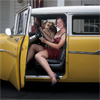Kathy Sdao Seminar: Why That "Treat Thing" Doesn't Always Work
Classical counter conditioning is a great foundation for working with a reactive dog. It's also very easy to do: a scary thing happens, and then you give the dog a treat. Over time, the dog learns that the scary thing predicts good things, which changes his feelings. He's no longer scared, which will hopefully mean that the fear-based behavior will disappear. Still, sometimes you'll hear someone say “I tried that whole treat thing, and it just didn't work...”
And you know what? I believe those people. Classical conditioning, while pretty straightforward, does require that you get some of the details straight. Kathy shared the errors that people commonly make that can prevent progress, or even worse, create even more problems. If you're struggling with that “whole treat thing,” here are eight things you should check.
(If you aren't familiar with the basics of classical conditioning, check out this post, and then this one. Today's entry will make a lot more sense if you do.)
Make Sure Your Timing is Right
This is perhaps the area you can screw up the most. In classical conditioning, the second thing that happens is the most important because it is the one that will determine what kind of association is formed. If that second thing is positive, the association will become positive. If the second thing is scary, though, then the association will become scary, too. In other words, when you give the treat matters, and it matters a lot.
There are four basic ways to pair stimuli. Trace conditioning happens when there is a 1-2 second delay between the two stimuli. For example, if you want the dog to learn that a bell ringing predicts that food is coming, in trace conditioning, you would ring the bell, wait 1-2 seconds, and then give the dog the treat. Delayed conditioning occurs when the first stimuli is presented continuously for several seconds (the bell rings several times in a row), and then food is presented immediately. Simultaneous conditioning means that both stimuli are presented at the same time; you ring the bell and give the food at the same time. Finally, backward conditioning, like the name implies, is when you reverse the stimuli. You give the food and then ring the bell.
Although there are scientific uses for all of these, when it comes to training a reactive or fearful dog, both simultaneous and backward conditioning is basically useless. Simultaneous conditioning will simply have little to no result. Backward conditioning, however, is much worse. Instead of the bell predicting the treat, the treat predicts the bell. This can have devastating consequences. If a scary thing predicts food, then the food becomes associated with fear. When this happens, the mere presence of food can cause a dog to shut down or react. Not a good thing.
Most people don't set out to get this order wrong. We understand how it should work, but where we go astray is in assuming that the dog sees the scary thing at the same time we do. Therefore, you should be sure to give the treat only after the dog has perceived the stimuli/scary thing.
Make Sure You Avoid Rhythmic Trials
We humans are creatures of habit- when we set up training experiences, we tend to fall into patterns. Unfortunately, dogs are very talented at discerning patterns, so we need to make sure that our trials are not rhythmic. Kathy gave the example of working with a dog who is afraid of men. If she were to enlist a male friend and directed him to walk in and out of eyesight, it's likely that he would begin doing so at regular intervals. Unfortunately, what the dogs often learn in these scenarios is not that the presence of men predicts steak, but rather, that steak happens every 20 seconds or so, and if you get a positive association, it's very weak. You will get a far better result if you make sure that your trials are random and varied.
Make Sure There Are No Competing Stimuli
Since the second event matters most, we need to make sure that we know what it is. Sure, we might think the pairing is simple- see scary thing, get a treat- but dogs are highly observant. Does he know he's getting a treat as a result of the scary thing, or is something happening in between those two events? Common pitfalls include reaching in a pocket, or crinkling a treat bag as we get the snack out. Again, associations can and do happen in these situations, but they are weaker than if it was direct, with no middleman. Try to set up the situation to reduce as many competing stimuli as possible.
Make Sure You're Using a High Value Treat
Kathy advises that you use the absolute best thing you can in order to create the most intense response possible. Classical conditioning follows a pretty steep curve, which means that you'll get the strongest response possible fairly early on in training. Don't squander this opportunity by using kibble. Sure, the dog will learn that scary things predict food, and that's good... but it's not awesome. Think about it: do you want an, “Oh, yes, kibble, thank you” response, or do you want the “HOLY COW I JUST GOT RAW TRIPE” response?
Make Sure Your Treat Remains Special
Classical conditioning works best when the contingency is strong. In non-science speak, this means that it works best when the awesome thing that follows the trigger happens only when the trigger does. No matter how much your dog loves cheese, if cheese happens all the time, it becomes meaningless. For that reason, Kathy recommended that you have a treat that you use only for counter-conditioning. Actually, she said that it would be best if all food happened only as a direct result of the scary thing, but since that's pretty much impossible, practically speaking, she recommended reserving the high value treat for your counter-conditioning work.
Make Sure You Aren't Lumping Criteria
Remember what I said about competing stimuli? Well, that counts for the first stimuli as well as the second. Make sure you aren't trying to counter-condition against too many things at once. It really works best to tackle one scary thing at a time. So, if your dog is afraid of men, and he's afraid of people riding bikes, men riding bikes might be too much. Try breaking it down more if you can.
Make Sure the Trigger Always Predicts Good Stuff
Classical conditioning is not operant conditioning. As such, it is not maintained by intermittent reinforcement, and is much more prone to extinction as a result. Instead, for classical conditioning to work, the scary thing pretty much always needs to be followed by the treat. Every time the dog sees a scary toddler, a piece of chicken should follow. Every time. If toddlers appear and chicken doesn't, then the dog learns that toddlers are not a very reliable predictor. If you're lucky, the dog will still develop a lukewarm response. If you're not, though, the dog will not make an association at all, meaning that you're doing all that work for nothing.
Your job is to find a way to avoid the trigger when you're not training. This means either carrying chicken and going everywhere with your dog, or not doing certain things with your dog. And yes, this includes walks and going potty. Speaking of which...
Make Sure You Switch to an Operant Technique
Since classical conditioning requires a near 100% trigger-treat response, it simply cannot be considered a long-term strategy. At some point, Kathy said, you just have to switch to an operant training strategy. This might be something like auto-watches or emergency U-turns, or it might be something “fancier” like BAT or Look at That. The technique you choose doesn't matter as much as the fact that you choose an operant behavior for your dog to perform at some point since that can be reinforced intermittently, allowing you the ability to just relax and enjoy your dog sometimes.
As you can see, there are plenty of opportunities for you to undermine the work you're doing. This is just part of the reason I advocate working with an experienced trainer when you're trying to modify your dog's behavior. I know I certainly made plenty of mistakes along the way- I never did reserve the absolute best treat possible solely for counter-conditioning, and so of course, those treats happened all the time. I'm also often guilty of lumping criteria, and I'm sure I screwed up my timing now and then. Still, we muddled through, and while my efforts could have been better had I understood this information then, we did okay. But what about you guys? Any memorable mistakes? I'd love to know that I'm not alone in my training shortcomings...
"Why that 'treat thing' doesn't always work"
4 posts
• Page 1 of 1
http://reactivechampion.blogspot.com/20 ... thing.html
"I don't have any idea if my dogs respect me or not, but they're greedy and I have their stuff." -- Patty Ruzzo
"Dogs don't want to control people. They want to control their own lives." --John Bradshaw
"Dogs don't want to control people. They want to control their own lives." --John Bradshaw
-

TheRedQueen - I thought I lost my Wiener... but then I found him.
- Posts: 7184
- Location: Maryland
Like.
"Remember - every time your dog gets somewhere on a tight leash *a fairy dies and it's all your fault.* Think of the fairies." http://www.positivepetzine.com"
http://www.pitbullzen.com
http://inaradog.wordpress.com
http://www.pitbullzen.com
http://inaradog.wordpress.com
-

pitbullmamaliz - Working out in the buff causes chafing
- Posts: 15438
- Location: Cleveland, OH
amalie79 wrote:pitbullmamaliz wrote:Like.
Ditto.
Me too! Lots to think about! Thanks for sharing
-

Tubular Toby - Confident Young Bully
- Posts: 521
- Location: Stillwater, Oklahoma
4 posts
• Page 1 of 1
Who is online
Users browsing this forum: No registered users
